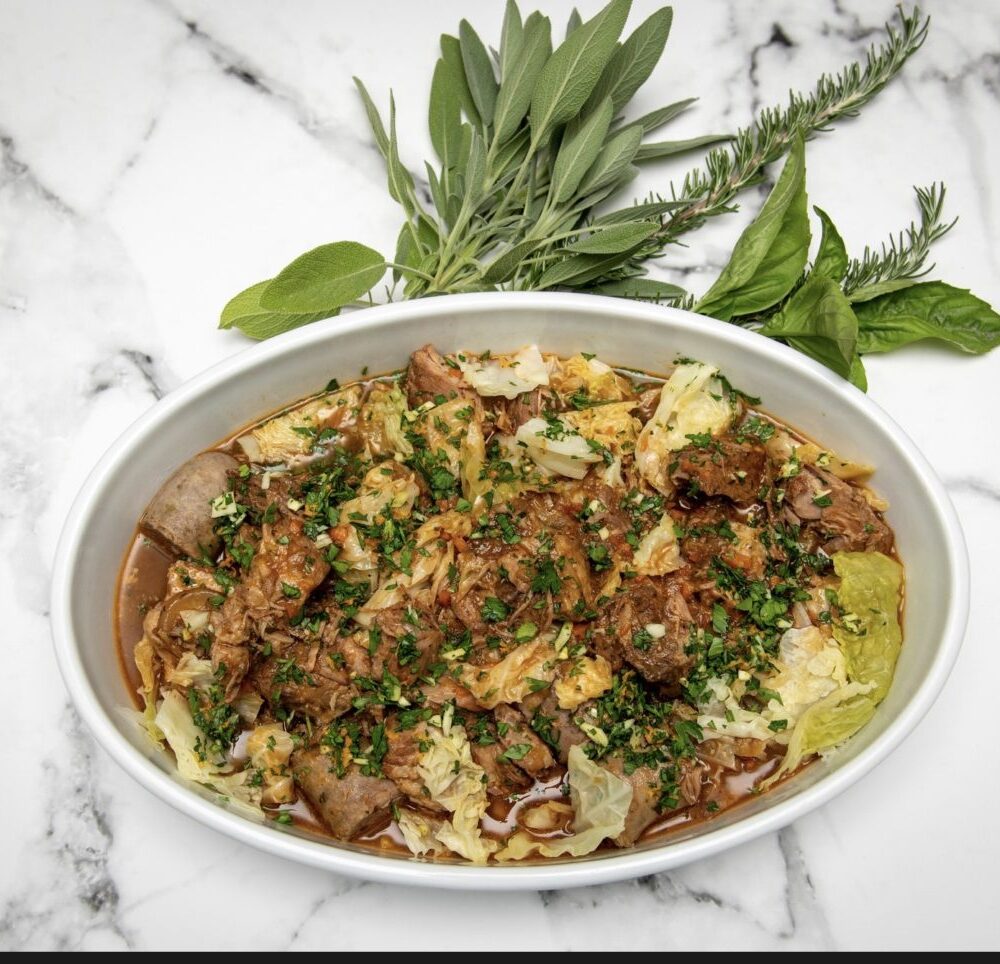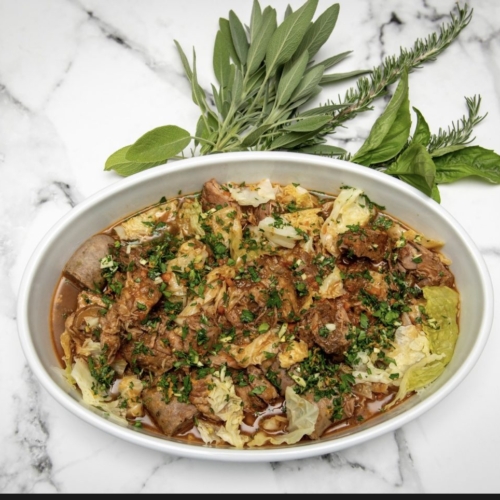

Bottaggio - Pork & Cabbage Stew
This dish comes from the Lombardia region of Italy, where my Father was born, and has been made for ages. If you go back in time when the farmers and villagers ate mostly what they grew or raised, you would find that they cooked with lard. There wasn't a huge production of olive oil in the region at that time, but they did raise pigs. This stew was traditionally made using the less tender parts of the pig, and it would contain the feet, nose, and ears and some of the rib bones. Nothing was wasted. However, in this day and age, we can use the more accessible cuts of pork, but I would encourage you to find fresh pork rind and use that. It adds a creamy richness to the broth, and a bit of a crunch in contrast to the soft, tender pork cubes.
Ingredients
- 2 lb Pork shoulder cut in to cubes (900g)
- 2 lb Assorted sausages (900g)
- 1/2 cup Fresh pork rind or Pancetta (110g)
- 1/2 cup Diced celery (80g)
- 1/2 cup Diced carrot (80g)
- 1/2 cup Diced yellow onion (80g)
- 2 Cloves of garlic, crushed
- 1/2 cup Italian parsley, finely chopped (30g)
- 2 tbsp Tomato paste (28g)
- 1/2 cup Dry red wine (117ml)
- 3 cup Veal stock, or 2 cups chicken and 1 cup beef (710ml)
- 4 cup Savoy cabbage, cut in to small chunks (455g)
- 2 tbsp Olive oil or lard (30g)
Gremolata
- 1/2 cup Minced Italian parsley (30g)
- 1 Garlic clove, minced
- 1 tbsp Orange zest (6g)
Instructions
- Heat a Dutch Oven or heavy stew pot over medium high heat. Add 1 tablespoon of the olive oil or lard. Sauté the sausages until nice and brown on the outside, then remove from the pot and set them aside. Salt and pepper the pork cubes, and add another tablespoon of the olive oil or lard to your pot. Sauté until the cubes are browned on all sides. When browned, remove to a platter. Add the pork rinds (or pancetta if you are using that) and sauté until crispy. Remove and set them aside.
- Now, add the celery, carrots, onions and garlic to the pot. Add a bit more oil or lard if needed. Sauté until the onions just starts to color. Pushing the vegetables to one side, create a small spot for the tomato paste, and stir the paste to caramelize. This takes about 3 minutes.
- Add the red wine, and use a wooden spatula to scrape all the browned bits from the bottom of the pot. When the wine has reduced by half, add the stock, the pork rinds (or pancetta), about half of the parsley, and the pork cubes, along with any juices that have accumulated on the platter.
- Cover the Dutch Oven or stew pot and place in a preheated 300° degree (150c) oven.
- While the pork is cooking, place the cabbage in a steamer and steam until el dente. This takes about 10 minutes. Remove and just set it aside.
- When the pork has cooked for 90 minutes, remove from the oven and add the sausages, the remaining parsley and the steamed cabbage. Put the lid back on, return to the oven for another hour, or until the pork is so tender that the meat can be separated using a fork.
- At this point, even though it is not traditional, I like to add about 1/4 cup of Dry Marsala. Stir in the wine, and cook for another 10 minutes. I think the Marsala gives the stew a richer, layered taste.
- This is best served over creamy polenta and sprinkled with Gremolata.
Directions for the Gremolata
- Mince the Italian flat leaf parsley, and the clove of garlic. Mix with the orange zest. This is a simple topping for many Italian dishes and is traditionally made using lemon zest. However, I really like the flavor of the orange zest for this dish.